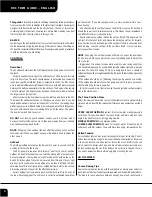
DECK SERIES OWNER’S MANUAL
13
|
P a g e
DECK SERIES
PERSONAL FLOTATION DEVICES (PFDS) AND ACCESSIBILITY
Federal law requires at least one wearable Type I, II, III or Type V Personal Flotation Device (“PFD”) for each person on-board
or being towed on water skis, wakeboards, surfboards, or other recreational equipment. A Type V PFD provides performance
of either a Type I, II or III PFD (as marked on its label) and must be used according to the label requirements. In addition, one
throwable Type IV PFD must also be on board. As the owner, obtaining the appropriate PFDs is your responsibility. You must
also determine whether people on-board, including those who are underage, are required to wear PFDs when underway. Your
NauticStar dealer can, and will be happy to, assist you with your purchase of appropriate PFDs. People on-board who cannot
swim or who are not strong swimmers, as well as children, should always wear PFDs.
• Wearable PFDs must be readily accessible in the boat.
• It should be possible to put on the PFDs within a reasonable amount of time in case of emergency.
• PFDs should never be stowed in plastic bags, in locked or closed compartments or have other gear stowed on top of them.
• The U.S. Coast Guard, as well as NauticStar, always recommends the wearing of PFDs when the vessel is underway, even though it is not a
requirement. The best PFD is the one that is worn and that can save your life.
• Inflatable PFDs must have a full cylinder and all status indicators on the inflator must be green, or the device is NOT serviceable, and is NOT
considered a usable PFD for anyone on-board the vessel.
• Coast Guard-approved inflatable PFDs are authorized for use on recreational boats by persons at least 16 years of age.
• Some states require children to always wear PFDs. Check with your state boating safety officials for details. Be certain to equip children with a PFD
that is appropriate for the size of the child. The label will indicate the weight limits for use.
NOTE: Requirements for coastal waters and inland waters differ. Check with the local boating authorities for more
information.
IN THE EVENT OF A FIRE
Fire on-board is among the most serious of matters that boaters can experience. Due to the proximity of fuel tanks and
several electrically operated items that can result in a spark or arc, any and all fires on a boat should be a matter for
immediate action. If the extinguishing/suppression materials do not quickly extinguish the fire, it may become necessary to
abandon ship. Make sure everyone on board has a PFD and swims as quickly and as far as possible, up wind and upstream
from the boat. If gasoline is released, it will float on top of the water. It may spread out or move with the body of water’s
current.
FIRE EXTINGUISHERS
Every boat NauticStar builds is required by law to have on board one (1) 2.5-pound, dry chemical fire extinguisher rated for
Type A, B and C fires. The dry chemical fire extinguisher can be purchased from any authorized NauticStar dealer or other
authorized retailers. If the fire extinguisher has been discharged, it must be replaced with a fire extinguisher that is rated
for Type A, B and C fires from an authorized NauticStar dealer or another source.
Summary of Contents for Deck Series
Page 1: ...NAUTICSTAR DECK SERIES OWNER S MANUAL 193 SC 203 SC 203 DC 223 DC 243 DC 2022...
Page 22: ...DECK SERIES OWNER S MANUAL 22 P a g e DECK SERIES...
Page 52: ...DECK SERIES OWNER S MANUAL 52 P a g e DECK SERIES 203 SC...
Page 53: ...DECK SERIES OWNER S MANUAL 53 P a g e DECK SERIES 203 DC...
Page 54: ...DECK SERIES OWNER S MANUAL 54 P a g e DECK SERIES 223 DC...
Page 55: ...DECK SERIES OWNER S MANUAL 55 P a g e DECK SERIES 243 DC...














































